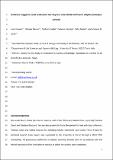Files in this item
Evidence suggests vocal production learning in a cross-fostered Risso’s dolphin (Grampus griseus)
Item metadata
| dc.contributor.author | Favaro, Livio | |
| dc.contributor.author | Neves, Silvana | |
| dc.contributor.author | Furlati, Stefano | |
| dc.contributor.author | Pessani, Daniela | |
| dc.contributor.author | Martin, Vidal | |
| dc.contributor.author | Janik, Vincent M. | |
| dc.date.accessioned | 2017-10-19T08:30:10Z | |
| dc.date.available | 2017-10-19T08:30:10Z | |
| dc.date.issued | 2016-07 | |
| dc.identifier | 227255174 | |
| dc.identifier | fd68086c-4a51-401a-b725-7e3799efd162 | |
| dc.identifier | 84957951939 | |
| dc.identifier | 000377454000014 | |
| dc.identifier.citation | Favaro , L , Neves , S , Furlati , S , Pessani , D , Martin , V & Janik , V M 2016 , ' Evidence suggests vocal production learning in a cross-fostered Risso’s dolphin ( Grampus griseus ) ' , Animal Cognition , vol. 19 , no. 4 , pp. 847-853 . https://doi.org/10.1007/s10071-016-0961-x | en |
| dc.identifier.issn | 1435-9448 | |
| dc.identifier.other | ORCID: /0000-0001-7894-0121/work/60427872 | |
| dc.identifier.uri | https://hdl.handle.net/10023/11883 | |
| dc.description.abstract | Vocal learning is a rare skill in mammals, and we have limited information about the contexts in which they use it. Previous studies suggested that cetaceans in general are skilled at imitating sounds, but only few species have been studied to date. To expand this investigation to another species and to investigate the possible influence of the social environment on vocal learning, we studied the whistle repertoire of a female Risso’s dolphin (Grampus griseus) that was stranded at an early age and was subsequently raised in a group of bottlenose dolphins (Tursiops truncatus). We show that this cross-fostered animal produced vocal signals more akin to those of its Tursiops poolmates than those of Risso’s dolphins in the wild. This is one of very few systematic cross-fostering studies in cetaceans and the first to suggest vocal production learning in the Risso’s dolphin. Our findings also suggest that social experience is a major factor in the development of the vocal repertoire in this species. | |
| dc.format.extent | 510843 | |
| dc.language.iso | eng | |
| dc.relation.ispartof | Animal Cognition | en |
| dc.subject | Bioacoustics | en |
| dc.subject | Bottlenose dolphin | en |
| dc.subject | Grampus griseus | en |
| dc.subject | Risso's dolphin | en |
| dc.subject | Signature whistles | en |
| dc.subject | Tursiops truncatus | en |
| dc.subject | QH301 Biology | en |
| dc.subject | QP Physiology | en |
| dc.subject.lcc | QH301 | en |
| dc.subject.lcc | QP | en |
| dc.title | Evidence suggests vocal production learning in a cross-fostered Risso’s dolphin (Grampus griseus) | en |
| dc.type | Journal article | en |
| dc.contributor.institution | University of St Andrews. Sea Mammal Research Unit | en |
| dc.contributor.institution | University of St Andrews. School of Biology | en |
| dc.contributor.institution | University of St Andrews. Marine Alliance for Science & Technology Scotland | en |
| dc.contributor.institution | University of St Andrews. Scottish Oceans Institute | en |
| dc.contributor.institution | University of St Andrews. Institute of Behavioural and Neural Sciences | en |
| dc.contributor.institution | University of St Andrews. Centre for Social Learning & Cognitive Evolution | en |
| dc.contributor.institution | University of St Andrews. Bioacoustics group | en |
| dc.identifier.doi | 10.1007/s10071-016-0961-x | |
| dc.description.status | Peer reviewed | en |
This item appears in the following Collection(s)
Items in the St Andrews Research Repository are protected by copyright, with all rights reserved, unless otherwise indicated.

